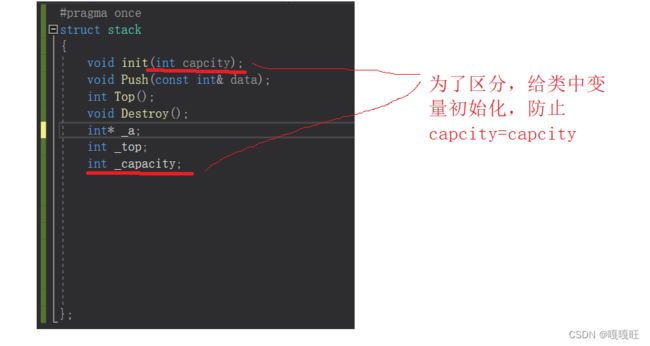【c++】类和对象1
1.面向过程和面向对象初步认识
C语言是面向过程的,关注的是过程,分析出求解问题的步骤,通过函数调用逐步解决问题。

C++是基于面向对象的,关注的是对象,将一件事情拆分成不同的对象,靠对象之间的交互完
成

2.类的引入
C语言结构体中只能定义变量,在C++中,结构体内不仅可以定义变量,也可以定义函数。比如:
之前在数据结构初阶中,用C语言方式实现的栈,结构体中只能定义变量;现在以C++方式实现,
会发现struct中也可以定义函数。
#include 上面结构体的定义,在C++中更喜欢用class来代替。
3.类的声明与定义
1.上面的那种方法,定义和声明都在类里面
2.定义和声明分开
stack.cpp
#include stack.h
#pragma once
struct stack
{
void init(int capcity);
void Push(const int& data);
int Top();
void Destroy();
int* _a;
int _top;
int _capacity;
};
源.cpp
#include 注意:类声明放在.h文件中,成员函数定义放在.cpp文件中,注意:成员函数名前需要加类名::
4.类的访问限定符及封装
- public修饰的成员在类外可以直接被访问
- protected和private修饰的成员在类外不能直接被访问(此处protected和private是类似的)
- 访问权限作用域从该访问限定符出现的位置开始直到下一个访问限定符出现时为止
- 如果后面没有访问限定符,作用域就到 } 即类结束。
- class的默认访问权限为private,struct为public(因为struct要兼容C)
【面试题】
解答:C++需要兼容C语言,所以C++中struct可以当成结构体使用。另外C++中struct还可以用来
定义类。和class定义类是一样的,区别是struct定义的类默认访问权限是public,class定义的类
默认访问权限是private。
5.类的作用域
类定义了一个新的作用域,类的所有成员都在类的作用域中。在类体外定义成员时,需要使用 ::
作用域操作符指明成员属于哪个类域。
struct stack
{
void init(int capcity);
void Push(const int& data);
int Top();
void Destroy();
int* _a;
int _top;
int _capacity;
};
void stack:: init(int capcity)
{
_a = (int*)malloc(sizeof(int) * capcity);
if (_a == nullptr)
{
perror("malloc fail");
return;
}
_capacity = capcity;
_top = 0;
}
这里的init属于stack这个类域
6.类的实例化
1.用类类型创建对象的过程,称为类的实例化
2. 一个类可以实例化出多个对象,实例化出的对象 占用实际的物理空间,存储类成员变量
3.做个比方。类实例化出对象就像现实中使用建筑设计图建造出房子,类就像是设计图,只设
计出需要什么东西,但是并没有实体的建筑存在,同样类也只是一个设计,实例化出的对象
才能实际存储数据,占用物理空间
struct stack
{
void init(int capcity);
void Push(const int& data);
int Top();
void Destroy();
int* _a;
int _top;
int _capacity;
};
int main()
{
stack st;
}
st就是类的实体化。
7.如何计算类对象的大小
/ 类中既有成员变量,又有成员函数
class A1 {
public:
void f1(){}
private:
int _a;
};
// 类中仅有成员函数
class A2 {
public:
void f2() {}
};
// 类中什么都没有---空类
class A3
{};
sizeof(A1) : 4__ sizeof(A2) : 1__ sizeof(A3) : 1__
#include 
结论:一个类的大小,实际就是该类中”成员变量”之和,当然要注意内存对齐,注意空类的大小,空类比较特殊,编译器给了空类一个字节来唯一标识这个类的对象。
8.this指针的引出
#include Date类中有 Init 与 Print 两个成员函数,函数体中没有关于不同对象的区分,那当d1调用 Init 函
数时,该函数是如何知道应该设置d1对象,而不是设置d2对象呢?
C++中通过引入this指针解决该问题,即:C++编译器给每个“非静态的成员函数“增加了一个隐藏
的指针参数,让该指针指向当前对象(函数运行时调用该函数的对象),在函数体中所有“成员变量”
的操作,都是通过该指针去访问。只不过所有的操作对用户是透明的,即用户不需要来传递,编
译器自动完成。
【面试题】
- this指针存在哪里?
- this指针可以为空吗?
答:this指针存在栈区中(类中的函数存在代码段中).
#include 第一个空指针没有解引用
第二个空指针解引用导致崩溃

